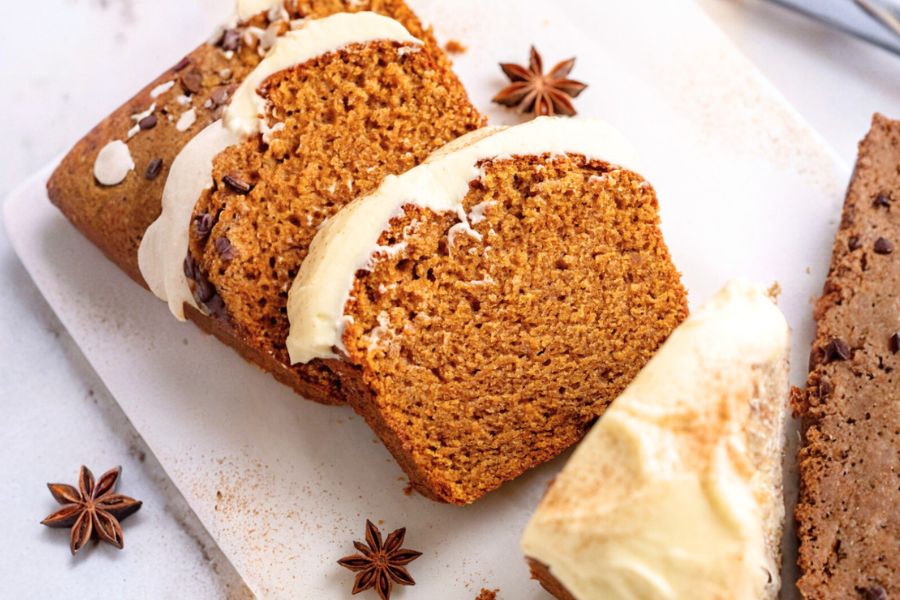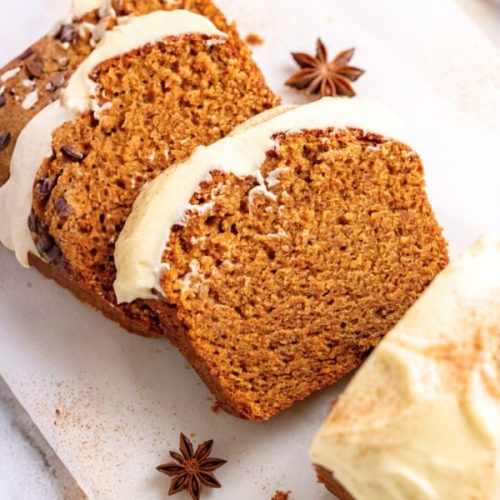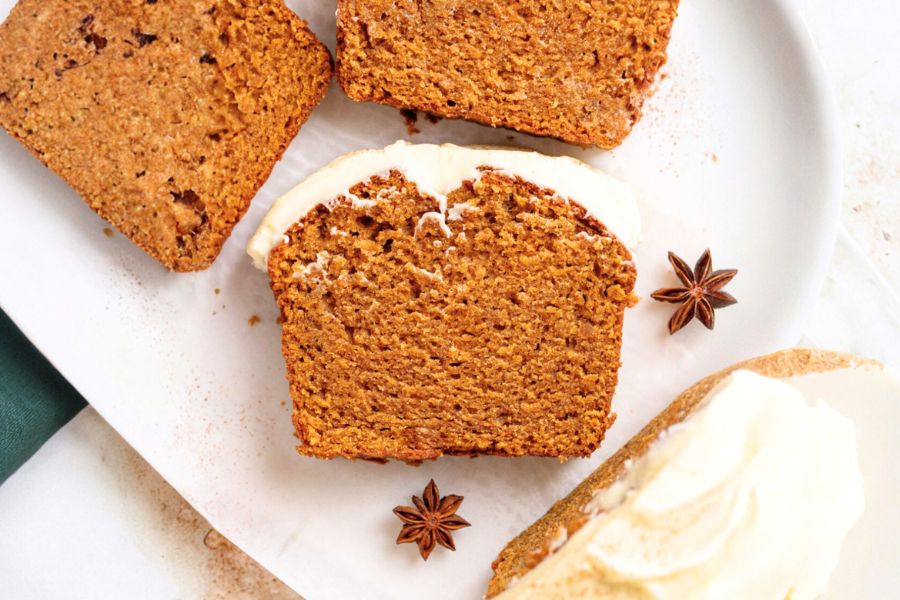This Sweet Potato Bread recipe stands out for its moist, fluffy texture and rich flavor, thanks to the natural sweetness of baked sweet potatoes combined with warm spices like cinnamon and nutmeg.
Beyond its delightful taste, this bread offers nutritional benefits such as a moderate amount of protein from eggs and cream cheese, alongside fiber from the sweet potato, which supports digestion and sustained energy.
The use of vegetable oil provides heart-healthy fats while keeping saturated fat relatively low.
Topped with a luscious cream cheese frosting, it balances indulgence with wholesome ingredients.

Quick to prepare and requiring simple pantry staples, this recipe is perfect for everyday cooking, whether for breakfast, snacks, or dessert.
Its easy process and make-ahead potential also make it an ideal choice for meal prepping or sharing with family and friends.
Must-Have Tools for Perfect Results
Loaf Pan (21.5 x 11.5 cm / 8.5 x 4.5 in)
Essential for shaping the sweet potato bread into the classic loaf form. Its sturdy design ensures even baking and browning, making it a versatile piece for bread, cakes, and meatloaf.
Food Processor
Perfect for pureeing baked sweet potatoes into a smooth, creamy texture that blends seamlessly into the batter. Beyond this recipe, it’s invaluable for chopping, mixing, and making doughs effortlessly.
Hand Whisk
Ideal for combining wet ingredients smoothly and incorporating the batter without overmixing. Lightweight and easy to use, a whisk is a staple tool for sauces, dressings, and batters alike.
Stand Mixer or Hand Mixer
Crucial for whipping the cream cheese frosting to a fluffy, airy consistency. This tool also saves time and effort in baking and cooking, making it a must-have for any avid baker.
Sifter
Ensures powdered sugar is lump-free before folding it into the frosting, resulting in a silky smooth texture. A sifter is also great for dusting baked goods with powdered sugar or cocoa powder for elegant presentation.

Fluffy Sweet Potato Bread
Equipment
- 1 loaf pan (21.5 x 11.5 cm / 8.5 x 4.5 in)
- Food Processor
- Hand whisk
- Stand mixer or hand mixer
- Sifter
Ingredients
For the Sweet Potato Bread:
- 230 grams all-purpose flour
- 100 grams granulated sugar
- 150 grams dark brown sugar
- 1 teaspoon baking powder
- ½ teaspoon baking soda
- 1 ½ teaspoons ground cinnamon
- ½ teaspoon ground ginger
- ¼ teaspoon ground allspice
- ¼ teaspoon ground nutmeg
- ½ teaspoon salt
- 300 grams baked sweet potato puree cooled to room temperature
- 110 grams vegetable oil at room temperature
- 2 large eggs room temperature
- 1 teaspoon vanilla extract
For the Cream Cheese Frosting:
- 100 grams unsalted butter
- 50 grams full-fat cream cheese
- 180 grams powdered sugar sifted
- ½ teaspoon vanilla bean paste or vanilla extract
Instructions
- Prepare the Oven and Pan: Begin by preheating your oven to 175ºC (350ºF) using the conventional bake setting. While the oven warms, take a loaf pan measuring approximately 21.5 x 11.5 cm (8.5 x 4.5 inches) and grease it thoroughly with butter or non-stick spray. To ensure easy removal of the bread after baking, line the pan with parchment paper, allowing some paper edges to hang over the sides for a simple lift-out later.
- Combine Dry Ingredients: In a large mixing bowl, sift together the all-purpose flour to break up any lumps and incorporate air for a lighter texture. Add the granulated sugar and dark brown sugar for a balanced sweetness and depth of flavor. Next, sprinkle in the baking powder and baking soda—both vital leavening agents that help the bread rise. Carefully add the ground cinnamon, ground ginger, allspice, and nutmeg, which will infuse the bread with warm, comforting aromas and taste. Finally, mix in the salt, which enhances the flavors of the spices and sweetness. Use a whisk or spatula to thoroughly combine all these dry ingredients so they are evenly distributed.
- Prepare the Sweet Potato Puree: If you haven’t already done so, bake or roast your sweet potatoes until soft and tender (this usually takes about 45-60 minutes at 200ºC/400ºF). Allow them to cool completely to room temperature to avoid affecting the texture of the batter. Scoop out the flesh from the skin and transfer it to a food processor. Blend the sweet potato until completely smooth and creamy, ensuring no lumps remain. Measure out 300 grams of this puree and place it into a separate large mixing bowl.
- Mix Wet Ingredients: To the sweet potato puree, add the vegetable oil, which helps keep the bread moist and tender with a delicate crumb. Crack in the two eggs, making sure they are at room temperature for better emulsification and texture. Pour in the vanilla extract, which adds a subtle sweetness and aromatic depth. Using a hand whisk or electric mixer on low speed, beat these wet ingredients together until the mixture is smooth, homogenous, and slightly fluffy.
- Combine Wet and Dry Mixtures: Pour the wet sweet potato mixture gradually into the bowl containing the dry ingredients. Using a rubber spatula or a large spoon, gently fold the wet and dry ingredients together with slow, deliberate strokes. Mix just until no visible flour pockets remain and the batter appears uniform. Avoid overmixing, as this can develop gluten and result in a tougher bread texture. The batter will be thick but smooth.
- Prepare the Batter for Baking: Transfer the batter into the prepared loaf pan, spreading it evenly with the spatula to fill the corners and smooth the surface. For an attractive and classic finish, take a butter knife and carefully draw a straight line down the center of the batter’s surface—this helps the bread rise evenly and creates a nice top crust.
- Bake the Bread: Place the loaf pan in the preheated oven on the middle rack to ensure even heat distribution. Bake for approximately 1 hour and 5 to 15 minutes. Start checking for doneness around the 1-hour mark by inserting a toothpick or thin knife into the center of the loaf. When it comes out clean or with just a few moist crumbs, the bread is perfectly baked. If the tester has wet batter, continue baking and check every 5 minutes.
- Cool the Bread Properly: Once baked, carefully remove the loaf from the oven. Set the pan on a wire rack and allow the bread to cool in the pan for about 10 minutes. This brief resting time lets the bread firm up slightly and reduces the risk of it breaking apart when removed. After 10 minutes, gently lift the bread out using the parchment paper overhangs and place it directly on the wire rack to cool completely. Cooling fully is essential before frosting to prevent the cream cheese topping from melting.
- Prepare the Cream Cheese Frosting: While the bread cools, prepare the frosting. Remove the butter and cream cheese from the refrigerator about 10 minutes in advance to bring them to room temperature—this helps achieve a smooth, creamy frosting without lumps. Cut the butter into small cubes to encourage even mixing. Sift the powdered sugar to remove clumps, ensuring a silky texture.
- Cream Butter and Cream Cheese: In a stand mixer fitted with the paddle attachment, or using a hand mixer, begin by beating the cubed butter on high speed for 5 minutes. This step creates a light and fluffy base for the frosting. Stop the mixer occasionally to scrape down the sides of the bowl, ensuring everything is well incorporated. Next, add the cream cheese and vanilla bean paste or vanilla extract. Beat the mixture together on medium speed for about 1 minute until fully blended and smooth.
- Incorporate Powdered Sugar: Add the sifted powdered sugar gradually in two parts. Start by mixing in the first half on low speed, allowing it to absorb fully into the butter and cream cheese mixture. Scrape the sides of the bowl again to avoid any pockets of sugar. Then add the remaining powdered sugar and mix again on low speed until the frosting is smooth, thick, and spreadable.Finally, increase the speed briefly for about 1 minute to lighten the texture.
- Frost the Bread: Once the bread has cooled completely, spread the cream cheese frosting evenly over the top using an offset spatula or the back of a spoon. Aim for a smooth, even layer to create a beautiful finish. For an extra touch, you can pipe decorative swirls or patterns if desired. Slice and serve your delicious, moist sweet potato bread with cream cheese frosting for a comforting treat.
Notes
- Preparing Sweet Potatoes: To make smooth puree, roast or bake whole sweet potatoes until soft (about 45-60 minutes at 200ºC/400ºF). Let cool, then scoop out the flesh and blend until creamy. This step can be done a day ahead and stored refrigerated.
- Room Temperature Ingredients: Bringing eggs, oil, and sweet potato puree to room temperature helps the batter combine better, resulting in a more tender crumb.
- Mixing Batter: Stir the wet and dry ingredients gently until just combined to avoid overmixing, which can lead to a denser texture.
- Baking Tip: Insert a knife or toothpick into the center of the loaf towards the end of baking; if it comes out clean or with a few moist crumbs, the bread is done.
- Cooling: Allow the bread to cool in the pan for about 10 minutes before transferring to a wire rack to cool completely — this prevents it from becoming soggy.
- Frosting: Beat the butter first until fluffy before adding cream cheese and powdered sugar gradually for the smoothest, lightest frosting.
- Storage: Keep the frosted bread refrigerated and consume within 3-4 days for best freshness.
Chef’s Top Tips for Success
To achieve the best texture and flavor in your sweet potato bread, start by roasting the sweet potatoes until they are tender and naturally sweet.
Allow them to cool fully before pureeing, as warm puree can affect the batter’s consistency.
When mixing the wet and dry ingredients, stir gently and just enough to combine; overmixing can result in a denser loaf instead of a soft, fluffy crumb.
Use room temperature ingredients like eggs and oil to help everything blend smoothly, ensuring even baking.
Finally, when baking, keep an eye on the bread’s doneness starting around the one-hour mark—ovens vary, so testing with a toothpick is key.
Following these simple but essential techniques will guarantee a moist, flavorful loaf every time.
Serving Ideas to Impress Guests
Sweet potato bread pairs beautifully with a variety of accompaniments, making it versatile for different occasions.
Serve thick slices toasted with a pat of butter or a drizzle of honey for a quick breakfast or afternoon snack.
For an indulgent treat, top with the luscious cream cheese frosting included in the recipe, or spread some nut butter for added protein and richness.
This bread also complements a warm cup of chai or spiced coffee, accentuating its cozy spices.
For a festive twist, add chopped pecans or dried cranberries to the batter before baking, offering delightful texture and flavor contrasts that will impress family and friends.
Storage Tips to Keep Freshness
To maintain the sweet potato bread’s moistness and flavor, store it properly after baking.
Once fully cooled, wrap the loaf tightly in plastic wrap or place it in an airtight container. It can be kept at room temperature for up to two days.
For longer storage, refrigerate the bread, especially if it’s frosted, and consume within 3-4 days to prevent the cream cheese frosting from spoiling. Y
ou can also freeze slices individually wrapped in parchment and foil or stored in freezer bags, where they’ll keep well for up to two months.
To enjoy, thaw at room temperature or warm gently in a toaster or oven.
Common Questions About Sweet Potato Bread
1. Can I use canned sweet potato puree?
Yes, canned puree works well in a pinch. Just be sure it’s plain sweet potato without added sugar or spices. Measure the puree accurately and adjust moisture if needed.
2. What’s the best way to bake sweet potatoes?
Roasting whole sweet potatoes at 200ºC (400ºF) until tender is ideal. This method caramelizes their natural sugars and enhances flavor. You can also microwave them for a quicker option.
3. Can I make this bread gluten-free?
To make it gluten-free, substitute the all-purpose flour with a gluten-free flour blend suitable for baking. Adding a binding agent like xanthan gum may help maintain texture.
4. How can I store leftover cream cheese frosting?
Keep leftover frosting in an airtight container in the refrigerator for up to 5 days. Bring it to room temperature and re-whip before using to restore its smooth texture.
5. Is it possible to make this recipe vegan?
Yes, you can replace eggs with flax eggs (1 tbsp ground flaxseed + 3 tbsp water per egg) and use a plant-based butter and cream cheese alternative for the frosting.
This recipe has been adapted and simplified from the original version by juliemarieeats. We’ve refined the steps for a smoother cooking experience and added helpful notes, nutrition insights, and essential kitchen tools to make it even easier for home cooks.

